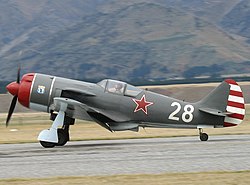Lavochkin La-9
| Lavochkin La-9 | |
|---|---|
 Replica of a La-9 |
|
| Type: | Fighter plane |
| Design country: | |
| Manufacturer: |
OKB Lavochkin , |
| First flight: |
May 1946 |
| Commissioning: |
December 20, 1946 |
| Production time: |
1946 to 1948 |
| Number of pieces: |
1882 |
The Lavochkin La-9 ( Russian Лавочкин Ла-9 , NATO reporting name Fritz ) was one of the last with piston engine powered fighter aircraft of the Soviet Union .
history
The La-9 was developed as a further development of the La-7 , taking into account the experience gained from the front. It was built with extensive use of duralumin and received new wings with a shorter span and an enlarged rudder . A 1,870 PS (1,375 kW) radial engine Schwezow ASch-82 FNW served as the drive . The cockpit has been completely redesigned. The La-9 was armed with four 20 mm SchWAK cannons arranged on the nose of the fuselage . On the La-9bis, they were replaced by four 23-mm NS-23 cannons .
The first flight of the La-130 prototype took place in early 1944. The La-9s were still in service with the Soviet air forces a few years after the end of the war , until they quickly became obsolete and decommissioned due to the rapid development of jet fighters. In August 1948, a small series of two-seat school hunters La-9UTI was produced.
The Chinese Air Force PLAAF also used the La-9 in the Korean War . More La-9s went to the Romanian and Hungarian Air Forces .
Five La-9s were delivered to the Aviation Technical School in Kamenz ( Volkspolizei - Dienststelle 500) for training purposes in 1952 to train personnel for the VP-Luft, but only for ground training.
Analogous to the La-7S (La-126PRWD), tests with Bondarjuk-PRWD-430 ramjet engines under the wings were carried out from the end of 1946 with a machine called the La-138 . This allowed the top speed to be increased briefly by 107 to 112 km / h. Experiments with pulse thrust tubes RD-13 (as La-9RD ) resulted in a speed increase of 127 km / h.
Technical specifications
| Parameter | Data |
|---|---|
| constructor | Semyon Lavochkin |
| span | 9.80 m |
| length | 8.625 m |
| height | 3.56 m |
| Wing area | 17.59 m² |
| Empty mass | 2,638 kg |
| Takeoff mass |
|
| Top speed | 690 km / h |
| Climbing ability | 1,064 m / min |
| Service ceiling | 10,800 m |
| Range | 1,735 km (825 l fuel) |
| Engine | 1 × Schwezow ASch-82FNW 14-cylinder double radial engine |
| power | 1,870 hp (1,375 kW) |
| Armament | 4 × 23-mm automatic cannons Nudelman-Suranow NS-23 with 300 rounds |
| crew | 1 |
See also
literature
- Bill Gunston: Technology and use of the fighter aircraft from World War I to the present day. Buch-Vertriebs-Gesellschaft, Wollerau 1977, p. 128 (original edition: Bill Gunston: The Encyclopedia of the World's Combat Aircraft. Hamlyn, London et al. 1976, ISBN 0-600-33144-X ( A Salamander Book )).
Web links
Individual evidence
- ↑ a b Ulf Gerber: The great book of Soviet aviation 1920–1990. Rockstuhl, Bad Langensalza 2019, ISBN 978-3-95966-403-5 , pp. 607 and 616
